Imagine stepping into a living room that perfectly reflects your style while feeling cozy and inviting—that’s the magic of well-designed apartment living rooms. These spaces have become increasingly popular because they showcase how to maximize small areas with big personality, blending comfort with chic aesthetics.
In this article, you’ll discover a diverse array of design ideas that cater to different tastes, from minimalist elegance to vibrant boho vibes. Whether you’re aiming for a serene retreat or a lively gathering spot, these ideas will inspire you to transform your apartment into a stylish haven that feels uniquely yours.
1. Cozy Corner Nooks with Plush Seating for Relaxation
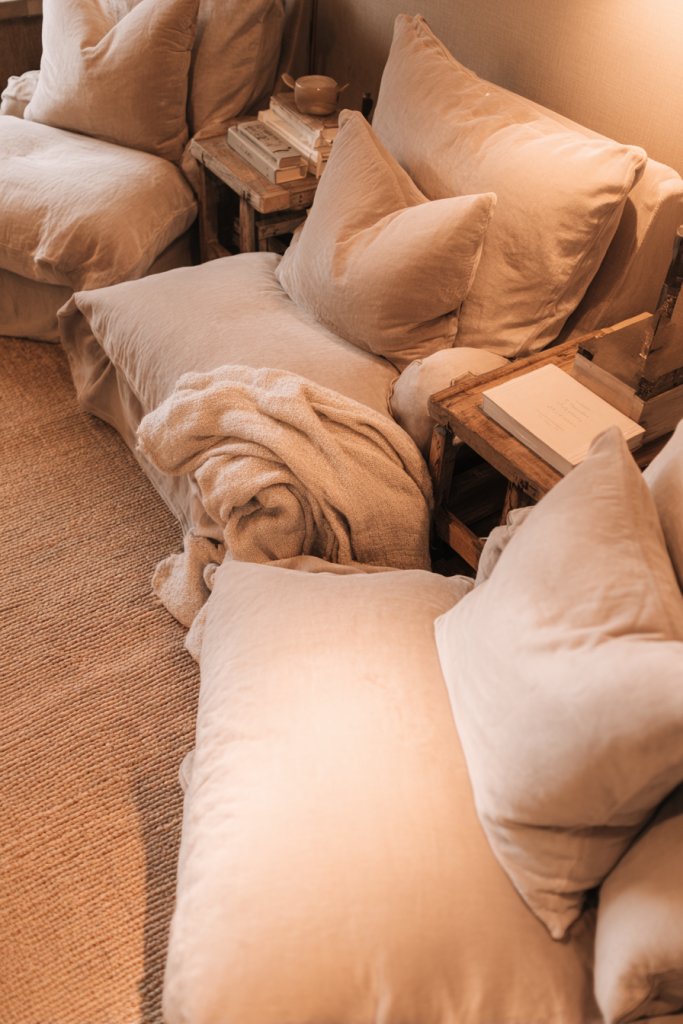
Ever find yourself craving a peaceful retreat right in your apartment? A cozy corner nook with plush seating can become your sanctuary from daily stress. It’s about creating a small haven where you can unwind, read, or just zone out. Many small spaces lack dedicated spots for relaxation, making this idea especially appealing.
Imagine sinking into a large, cushy armchair wrapped in a soft, cream-colored throw with textured knit. Next to it, a small side table holds your favorite mug, while a thick, shaggy rug cushions your feet. Warm ambient lighting from a nearby sconce or a standing lamp adds to the inviting atmosphere. These corners are designed to feel intimate, almost like a personal cocoon.
Adjust the size and shape based on your space—corner chairs for tight spots or a small loveseat for more room. Seasonal touches, like cozy blankets in winter or light, breathable fabrics in summer, can refresh the vibe. For a minimalist look, opt for neutral tones; for a lively feel, incorporate bold patterns or vibrant cushions. You can even add a small bookshelf or decorative elements that reflect your personality.
Start by identifying a quiet corner in your living area. Choose a comfortable chair or a small sectional that fits well. Layer it with plush cushions and throws—preferably in textures like velvet, faux fur, or chunky knits for maximum coziness. Install a soft, warm light source, such as a floor lamp or wall sconce, to avoid harsh overheads. Add a textured rug underneath to anchor the space visually and physically. Keep clutter at bay with a small side table or storage ottoman.
Personalize your nook with items that bring you joy—perhaps a collection of your favorite books, a quirky lamp, or artwork that sparks happiness. Experiment with different textiles and patterns to suit your mood or season. Use decorative baskets or storage cubes nearby to keep essentials handy without clutter. Changing cushion covers or throws regularly can keep the space feeling fresh and inviting.
Creating a cozy corner transforms your apartment into a more personal, welcoming space. It’s a small project with a big impact on your mental well-being. Once set up, it becomes your go-to spot for relaxation or reflection. This simple idea proves that even tiny corners can become your favorite retreat.
2. Multi-Functional Furniture for Space Optimization
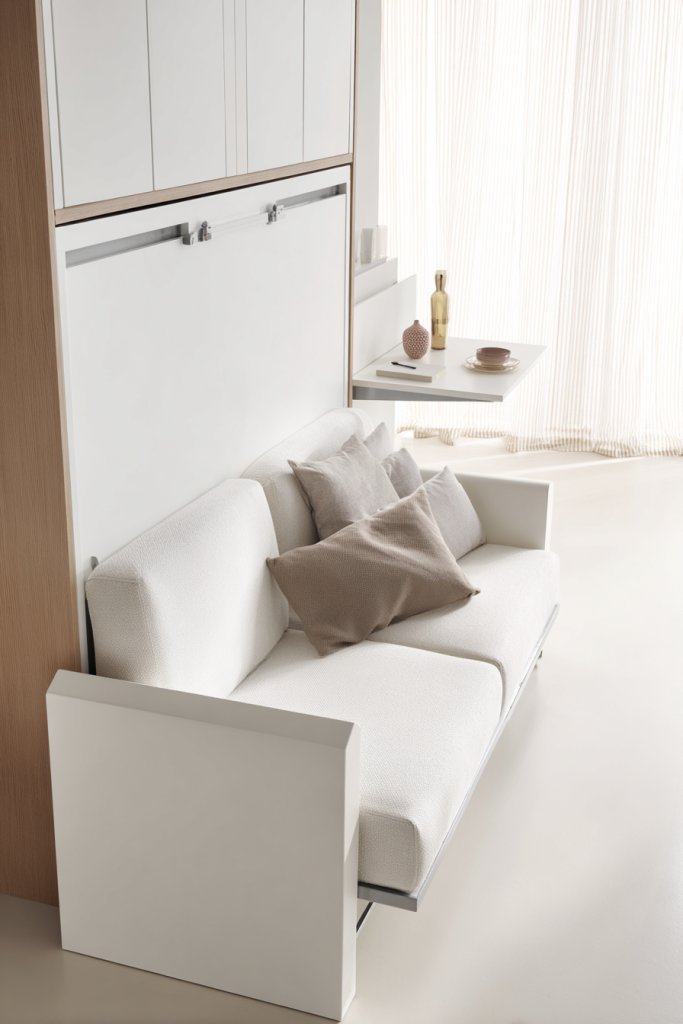
Living in a small apartment means making every inch count, right? Multi-functional furniture is the secret weapon for maximizing space without sacrificing style. It helps you do more with less, freeing up room for living, working, or just breathing comfortably. If clutter is your nemesis, this approach is a lifesaver.
Picture a sleek sofa that easily folds out into a bed or a stylish ottoman that doubles as a hidden storage unit. Imagine a fold-down desk mounted on the wall, ready to transform your living area into a workspace in seconds. These pieces blend seamlessly into modern decor, with clean lines and neutral tones that fit any aesthetic. The key is that they serve dual purposes, making your apartment feel larger and more functional.
Choose versatile pieces that match your style—be it minimalist, boho, or industrial. For smaller spaces, opt for wall-mounted fold-out tables and storage beds that tuck away when not in use. Larger apartments can incorporate sectional sofas with built-in storage or modular furniture that rearranges easily. Seasonal modifications, like swapping out cushions or covers, can refresh the look without buying new furniture.
Begin by assessing your most pressing space issues. Select furniture with multiple uses—like a sofa bed or storage ottoman—that fit your aesthetic and space constraints. Look for items with quality hardware and durable materials for daily use. Measure your space carefully before purchasing, ensuring mechanisms like fold-out beds or extendable tables fit comfortably. Assemble according to instructions or hire help for complex pieces. Incorporate smart storage solutions inside furniture to keep clutter hidden yet accessible.
Add personal touches with decorative textiles or custom slipcovers that match your decor. Use labels or baskets inside storage pieces to organize smaller items. Choose multi-purpose furniture in colors or textures that complement your existing decor, creating a cohesive look. Incorporate small, movable pieces that can adapt to your changing needs, like lightweight side tables or nesting stools.
This approach turns your apartment into a multifunctional haven, proving that space efficiency doesn’t mean sacrificing style. It’s a smart, budget-friendly way to upgrade your living situation. With a little planning, you can create a flexible environment that adapts to your lifestyle. Embracing multi-functional furniture boosts confidence in your ability to design a practical yet stylish home.
3. Warm Neutral Color Palettes for a Calming Atmosphere
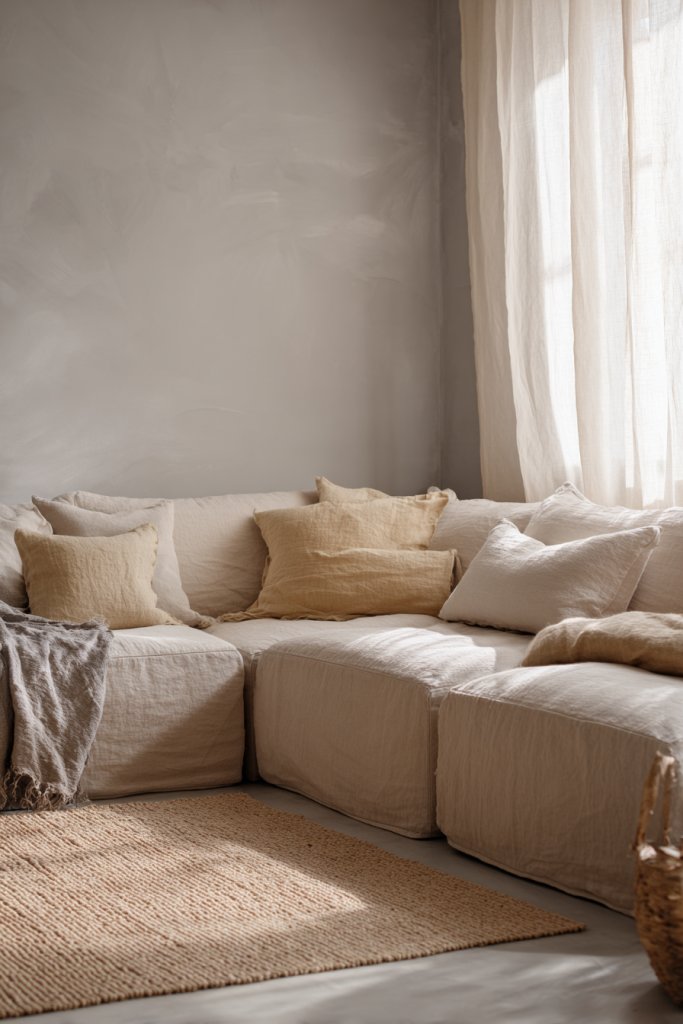
Ever feel overwhelmed by bright, busy spaces? A calm, inviting atmosphere starts with the right color palette. Warm neutrals like beige, taupe, and soft greys create a soothing environment that promotes relaxation. It’s about making your apartment feel like a sanctuary, not a chaotic mess. If tranquility is your goal, this is the way to go.
Imagine walls painted in a soft taupe, complemented by a plush cream rug and furniture in warm beige tones. Natural light filters through sheer curtains, enhancing the cozy, inviting vibe. Textured cushions and throws in shades of caramel or blush add depth without visual clutter. The overall effect is a space that feels peaceful, balanced, and effortlessly elegant. Such a color scheme also makes accessories pop subtly without overwhelming the senses.
Adjust the shades based on your preference—lighter tones for a bright, airy feel or deeper hues for a more grounded space. Incorporate seasonal accents like warm terracotta or muted olive for variety. For smaller rooms, stick to lighter shades to enhance openness; in larger spaces, deeper neutrals add warmth and intimacy. You can also layer textures—smooth walls, plush textiles, and matte finishes—to add visual interest while keeping the palette consistent.
Select wall colors in matte or eggshell finishes for a soft, non-reflective look. Use furniture in coordinating shades—think linen sofas, wooden accents, and soft upholstery. Incorporate textured textiles like woven throws or velvet cushions to add tactile warmth. Keep decor minimal and cohesive, avoiding busy patterns that break the calm. Use lighting to enhance the warm tones—warm LED bulbs or soft ambient lighting work best. Keep clutter minimal to preserve the serenity of the color palette.
Introduce subtle pops of color through accessories like cushions or throws, in shades like muted green or soft mustard. Incorporate metallic accents, such as brushed gold or bronze, for a touch of sophistication. Use decorative ceramics or textured baskets in similar tones to maintain harmony. Personalize your space with framed quotes or simple artwork that matches the calming vibe without overpowering it.
A neutral palette offers endless flexibility—add seasonal accents or switch up textiles to keep the space fresh. It’s a timeless choice that creates a peaceful retreat from hectic life. When your surroundings feel calm and cohesive, your mental space follows suit. Embrace these colors to craft a space where you can truly unwind and recharge.
4. Layered Rugs for Texture and Visual Warmth
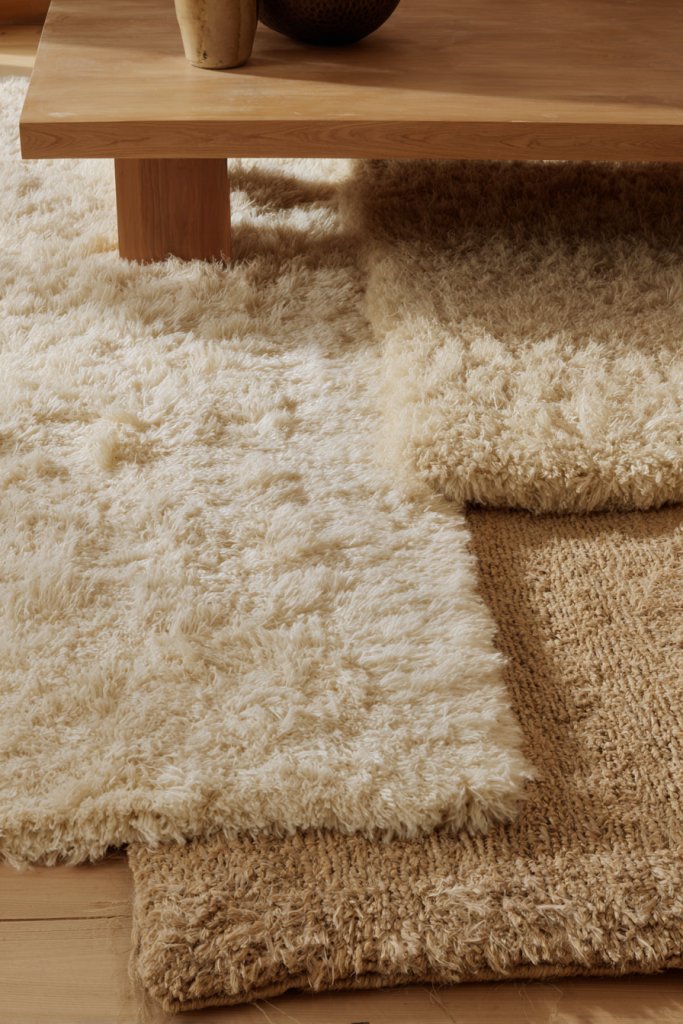
Does your living room feel flat or cold? Layered rugs are an easy way to add texture, warmth, and personality to your space. They create visual interest and can even define different zones within a single room. Plus, they hide imperfections in the flooring—hello, budget-friendly fix! If you want your apartment to feel cozy and inviting, layering rugs is a no-brainer.
Imagine a large, soft neutral-toned area rug anchoring your seating area. On top of it, a smaller, patterned rug adds a pop of color and visual complexity. The textures range from plush shag to woven jute, creating a tactile feast for your senses. The layered effect makes the space feel layered and curated, like a designer’s touch. When light hits the different textures, it plays beautifully, emphasizing depth and warmth.
Mix different sizes, shapes, and textures—think a vintage Persian rug over a modern jute mat. For seasonal changes, swap out lighter, airy rugs for plush, warm layers in winter. Play with color contrasts or stick to monochrome tones for a more subdued look. Layering also works well in open-plan spaces, helping to delineate zones like dining and lounging areas. Be playful and experiment with patterns and textures for maximum impact.
Start with a large base rug that covers your main seating area. Choose a second rug with contrasting texture or pattern to place on top, ensuring it’s slightly smaller to create a border effect. Use rugs with different pile heights—shag versus flat weave—to add tactile diversity. Secure lightweight rugs with rug pads to prevent slipping. Position the layered rugs so that their edges don’t bunch up or fold awkwardly, creating a seamless look. Clean and maintain regularly to keep textures vibrant.
Incorporate textiles like fringed throws or decorative cushions that match your rug layers. Add personal touches with vintage or handmade rugs for a boho vibe. Use rugs to highlight or separate different functional areas within a larger space. You can also layer with smaller mats or runner rugs to create a cozy pathway or reading nook. Changing out rugs seasonally helps keep the look fresh and inviting.
Layered rugs transform a plain room into a rich, inviting environment. They’re a simple, inexpensive way to elevate your decor instantly. When your space feels warm and textured, it encourages relaxation and socializing. Experimenting with different layers can become a fun decorating project, boosting your confidence in your style choices. Just have fun mixing textures—you’ll love the cozy results.
5. Minimalist Storage Solutions for Clutter-Free Living
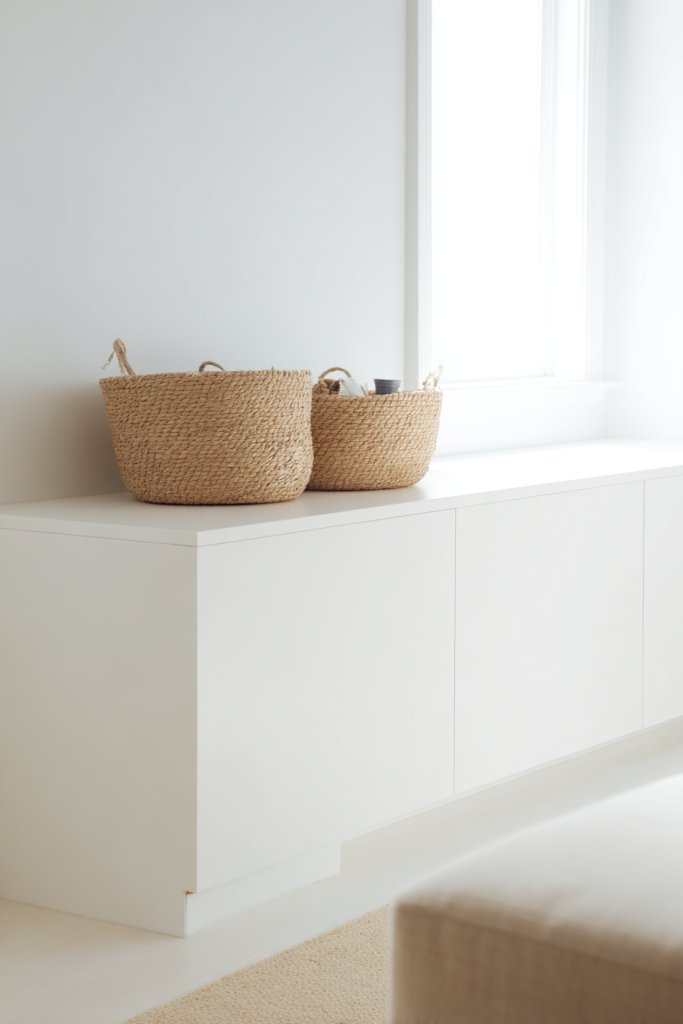
Clutter can turn even the most stylish apartment into a chaotic mess. Minimalist storage solutions help keep things tidy without sacrificing aesthetics. They create a sense of calm and order, making your space appear larger and more inviting. If clutter is your nemesis, mastering smart storage is the game changer.
Imagine sleek, wall-mounted shelves that hold only the essentials, leaving your surfaces clear. Hidden compartments within furniture, like a coffee table with built-in drawers, keep clutter out of sight. Use decorative baskets or fabric bins under the sofa or inside cabinets to organize smaller items. The overall look is clean, streamlined, and intentionally uncluttered, with each item having a designated place. It’s about simplifying without sacrificing style.
Choose storage pieces with a minimalist aesthetic—think matte finishes, neutral tones, and simple lines. Use vertical space by installing tall, slim cabinets or open shelving to maximize storage without encroaching on floor space. Incorporate multi-purpose furniture that doubles as storage, like ottomans or beds with drawers. Adjust your storage approach seasonally—swap out or reorganize to keep things fresh and functional.
Start by decluttering your space, sorting items into keep, donate, or discard piles. Select storage solutions that fit your needs—wall shelves, hidden compartments, or multi-use furniture. Measure your space carefully to avoid overcrowding. Install wall-mounted units at different heights to utilize vertical space efficiently. Use organizers, dividers, or labels inside cabinets to keep small items tidy. Regularly revisit your storage system to prevent clutter from creeping back in.
Customize storage with decorative elements like patterned boxes or textured baskets that add personality. Incorporate pull-out trays or modular units to adapt to different storage needs. Use labels or color coding to make organization intuitive. Personal touches, like a small collection of curated objects, can turn storage areas into design features while maintaining minimalism.
Smart storage solutions turn chaos into calm, making your home more peaceful. They show that you can keep your space beautiful and functional at the same time. When clutter is under control, your mental space clears too. Embrace minimalist storage as a core part of your home design journey—less truly is more.
6. Soft Textiles: Throw Blankets and Cushions for Comfort
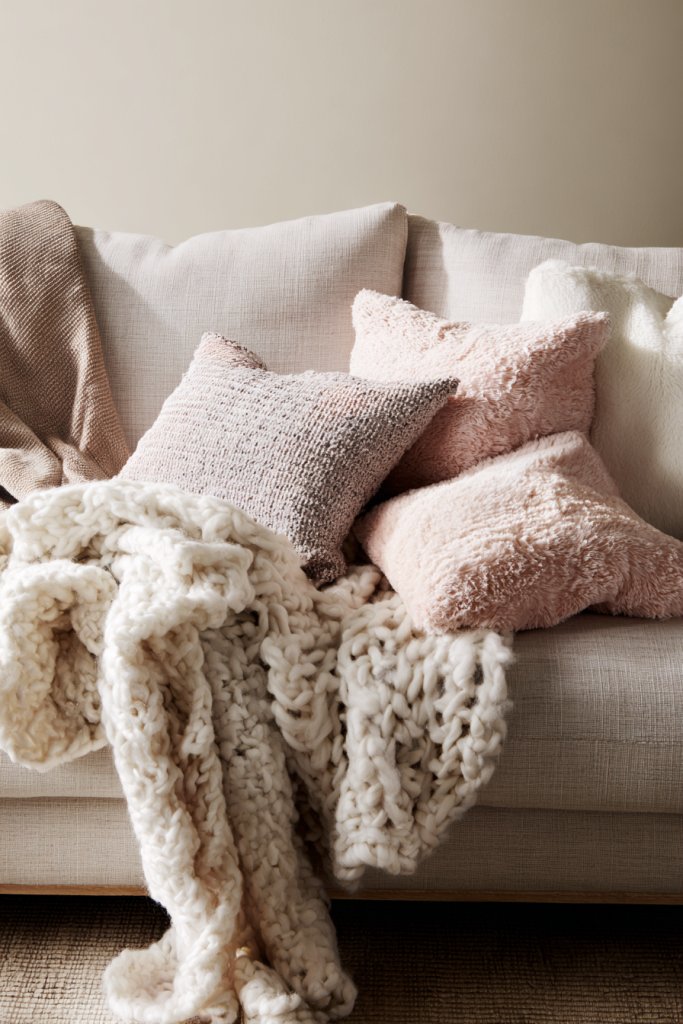
Who doesn’t love sinking into a comfy sofa after a long day? Soft textiles like throw blankets and cushions instantly boost comfort and add personality to your living room. They’re the easiest way to make your space feel warm and inviting. If your room feels a little cold or impersonal, textiles are your secret weapon.
Picture a plush velvet cushion in deep emerald paired with a chunky knit throw in warm caramel draped over your sofa. The textures invite touch, adding depth and richness. Mix different fabrics—silky, woven, faux fur—to create tactile layers that appeal to the senses. The colors can be subtle or bold, depending on your style, but the goal is comfort and visual interest.
Rotate cushions seasonally or by mood—think bright, cheerful patterns in summer and cozy, muted tones in winter. Mix and match textures to keep things lively but cohesive. Use cushions to highlight your color palette or add a pop of contrast. Throws can be lightweight for spring or plush for winter, giving your space versatility throughout the year.
Start with a few cushions in different sizes and textures that complement your furniture. Choose throws in easy-to-clean fabrics like cotton or fleece—especially if you have pets or kids. Drape blankets casually over sofas or chairs for an effortless, lived-in look. Use cushion covers that are removable for easy washing. Layer cushions and throws for a cozy, curated vibe, and switch them out for freshness.
Add personalized touches with embroidered initials or custom patterns. Incorporate seasonal colors or themes to match holidays or your favorite palettes. Use decorative trims or tassels to add flair. Keep a small basket nearby to store extra throws and cushions, making it easy to switch up the decor as you desire.
Soft textiles are a quick win for elevating your living space’s comfort level. They make your apartment feel more like a home, inviting relaxation and socializing. When your space is cozy and personalized, you’ll naturally want to spend more time there. Have fun mixing textures and colors—you’re creating your perfect comfort zone.
7. Compact but Stylish Coffee Tables

A coffee table is the centerpiece of your living room, but in small apartments, it can quickly become a space hog. Compact yet stylish options keep your space open while still serving as a functional spot for drinks, books, or decor. It’s all about balancing form and function without cluttering your floor plan.
Visualize a petite round table with a marble top and gold legs, perfectly proportioned next to a cozy sectional. Alternatively, a nesting set of tables can be pulled apart or stacked, offering flexibility. These tables feature sleek lines and minimal embellishments, making them versatile enough to fit any decor style. Their small footprint leaves plenty of room for movement or additional furniture.
Choose tables with built-in storage or multi-use features, like a tray top or lift-up lid. Opt for lightweight materials—acrylic, metal, or wood—that are easy to move around. You can also layer a small rug underneath to add visual interest and define the space. For seasonal updates, swap out decorative trays or accessories without changing the table itself.
Measure your available space carefully before selecting a table. Focus on compact shapes like circles or squares that fit easily into corners. Materials like glass or acrylic help keep the look airy, while wood adds warmth. Consider multi-functional pieces with storage compartments or foldable designs for extra practicality. Place the table within easy reach of seating for convenience. Regularly clean and maintain to keep it looking fresh.
Use decorative trays or small bowls to organize remotes, coasters, or snacks. Change the tabletop accessories seasonally—think candles, small plants (if allowed), or decorative objects. Customize with stickers or paint for a personal touch if the table is plain. Keep the look cohesive with your overall decor theme for a polished vibe.
A stylish, compact coffee table anchors your living space without overpowering it. It shows that small apartments can still be chic and functional. When your table is thoughtfully chosen, it enhances the entire room’s aesthetic. Embrace the challenge—small spaces demand clever, stylish solutions, and you’re proving it.
8. Floating Shelves for Decorative and Practical Use
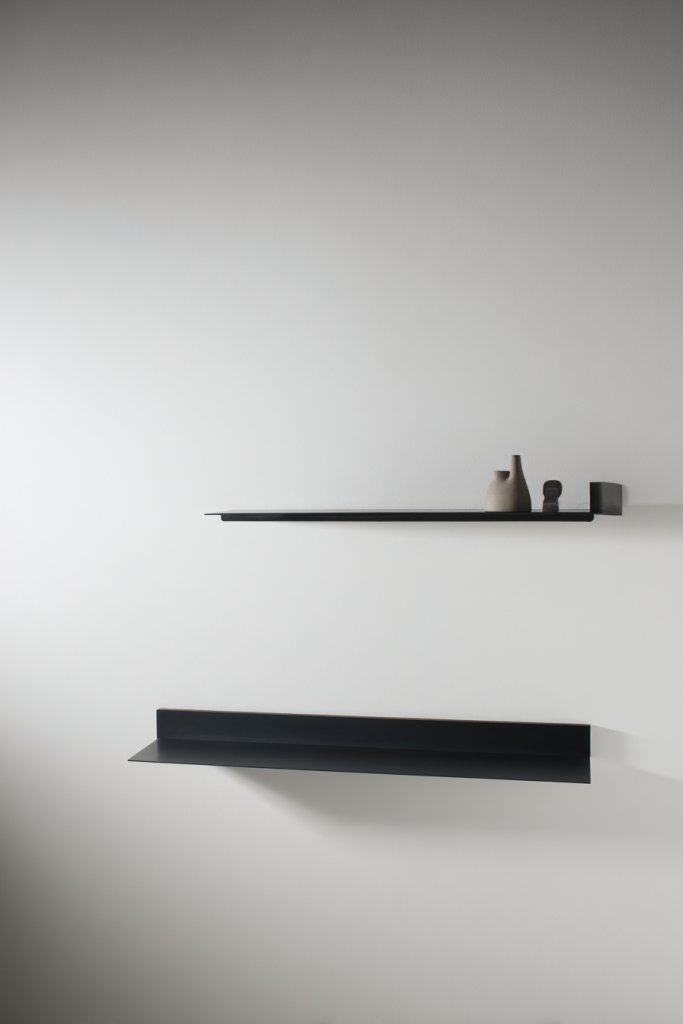
Looking to add storage without sacrificing wall space? Floating shelves are perfect for displaying your favorite items or storing essentials in a sleek, unobtrusive way. They keep your space feeling open and airy while offering practical benefits. If clutter is your concern, these shelves help you stay organized without visual overload.
Imagine a set of narrow, matte black floating shelves mounted above your sofa, holding neatly stacked books, baskets, or decorative objects. The shelves appear to ‘float,’ adding a modern, minimalist touch that elevates your decor. The clean lines and open space underneath make the room look larger and less crowded. When illuminated with warm LED strips, they create a soft glow that highlights your display.
Use different lengths and orientations for visual interest—horizontal, vertical, or staggered arrangements. Style with a mix of practical items like small baskets and decorative objects like sculptures or framed photos, avoiding artwork or plants if restricted. Change displays seasonally or for special occasions to keep things fresh. Choose materials that match your decor—wood, metal, or MDF—depending on your style.
Start by measuring wall space and selecting shelves that fit well without overcrowding. Use appropriate anchors and hardware for your wall type—drywall or brick. Install at eye level for easy access and visual balance. Keep weight limits in mind—avoid placing heavy objects on thin or narrow shelves. Arrange items thoughtfully, balancing height, color, and function. Regularly dust and check stability to ensure safety.
Display curated collections—like vintage cameras or ceramics—that reflect your personality. Use decorative storage boxes or labels to keep things neat behind the scenes. Incorporate different textures and finishes for variety, such as matte, gloss, or distressed wood. Personalize with small, meaningful objects that evoke memories or inspire you.
Floating shelves are a simple upgrade that adds style and function effortlessly. They demonstrate that smart wall storage can transform your space into a sleek, organized haven. With just a few tools and a bit of planning, you can create a polished look that’s uniquely yours. It’s all about making your walls work for you—no clutter, just style.
9. Open-Plan Layouts with Defined Zones

Feeling like your apartment is one big, chaotic space? An open-plan layout with clearly defined zones can bring order and flow to your living area. It helps you maximize space while creating designated spots for lounging, dining, or working. If zoning feels overwhelming, this approach makes it simple and stylish.
Visualize a spacious room divided by furniture placement—like a sofa acting as a natural divider between the living and dining areas. Rugs and lighting can further delineate zones without walls. A tall bookshelf or open shelving units serve as visual boundaries, while maintaining openness. The space feels cohesive yet organized, with each zone serving a distinct purpose. The overall aesthetic feels deliberate and balanced.
Use furniture placement—like a sectional or a sofa and armchair combo—to create natural boundaries. Incorporate different lighting or color schemes for each zone to emphasize separation. In seasonal or multi-use spaces, adapt by swapping furniture or adding portable screens or curtains if restrictions allow. Smaller apartments benefit from this approach, as it visually expands the space while providing functionality.
Start by planning your layout—measure your space and decide on zones. Position furniture to create clear pathways and avoid blocking windows or exits. Use rugs in different textures or colors to define each area. Lighting should highlight each zone—think accent lights or different table lamps. Avoid clutter in each zone to maintain clarity. Reorganize periodically to optimize flow and function.
Add personal decor items or textiles that match each zone’s purpose. Use different art or accessories (within restrictions) to subtly reinforce each area’s identity. Incorporate flexible elements like foldable tables or movable storage to adapt to changing needs. Keep the overall style cohesive, so the entire space feels unified but functional.
An open-plan with zones boosts the sense of space and purpose in your home. It shows that even small apartments can have distinct, functional areas. When well-executed, this layout makes your home feel larger and more welcoming. Embrace the challenge—defining zones makes your space more enjoyable and practical.
10. Vertical Space Utilization with Tall Storage Units
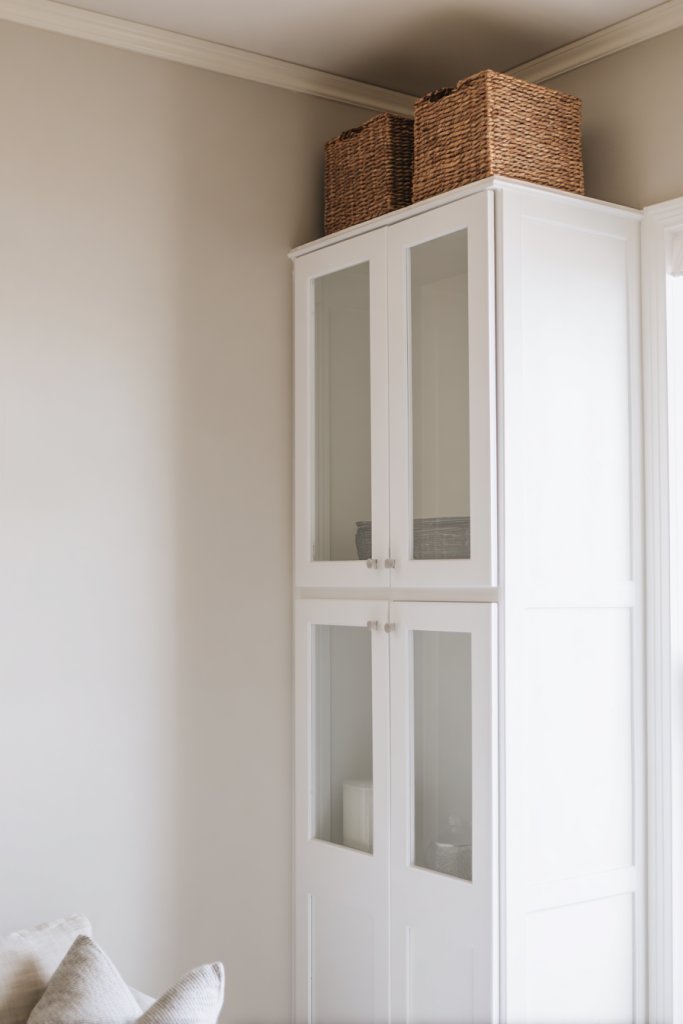
Struggling with limited floor space but craving more storage? Tall storage units are the perfect solution to go vertical. They help you keep clutter out of sight while making your apartment feel more spacious. It’s a clever way to maximize every inch without sacrificing style or comfort.
Picture a tall, sleek bookshelf stretching from floor to ceiling, filled with neatly organized books, baskets, and decorative objects. The vertical lines draw the eye upward, creating the illusion of height and openness. The design can be minimalist with clean lines or more ornate with intricate details, depending on your taste. The overall effect is a functional, decorative feature that adds personality to your space.
Use different finishes—natural wood, painted, or metal—to match your decor. Incorporate adjustable or modular units to customize your storage. In small spaces, opt for narrow, tall units that fit into corners or wall gaps. For a more eclectic look, mix open shelves with closed cabinets. Seasonal or thematic decor can be easily rotated on the shelves.
Choose a tall storage piece that fits your space—measure carefully. Anchor it securely to the wall for safety, especially if you live in a high-traffic area or have children. Organize items by size or category, using boxes or baskets for smaller objects. Install in a spot that doesn’t obstruct pathways or windows. Regularly declutter and reorganize to keep the system efficient. Keep the top surface clear or styled with decorative accents.
Personalize with decorative labels, artwork, or themed accessories that reflect your personality. Incorporate lighting—such as strip lights inside open shelving—to highlight your collection. Use a mix of open and closed storage to balance accessibility with a tidy appearance. Add decorative elements like vintage finds or curated collections for visual interest.
Vertical storage turns underutilized space into a powerful feature that elevates your decor. It proves that you don’t need a mansion to have ample storage—just smart choices. When you master this, your apartment feels more organized and less cluttered. It’s a simple trick that makes a big difference, boosting your confidence in home organization.
11. Personal Touches with Minimalist Wall Art
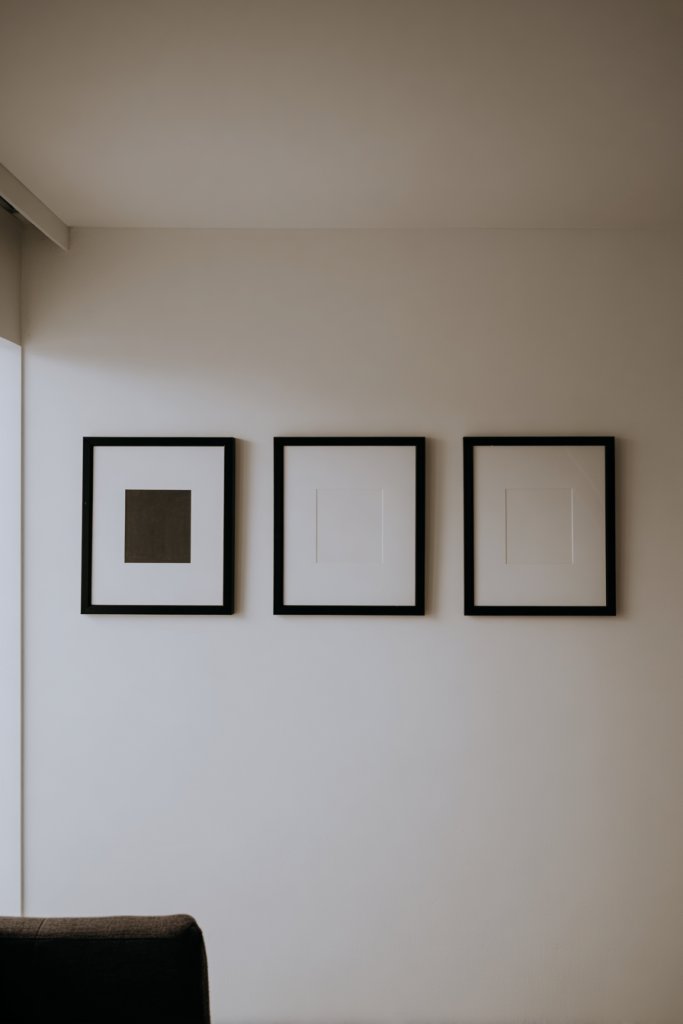
Your walls are like a blank canvas waiting to tell your story, but too much clutter can feel overwhelming. Minimalist wall art offers a subtle way to add personality without cluttering your space. It enhances your decor with clean, simple lines that evoke calm and sophistication. If your space feels too sterile, this is your go-to trick.
Imagine a single, framed black-and-white photograph or a geometric line drawing hanging above your sofa. The art is understated yet impactful, drawing the eye without competing with other decor. The frame’s sleek profile and neutral tones keep the look modern and refined. The negative space around the art adds to the sense of openness and calm. It’s about making a statement with less.
Choose art in monochrome, soft pastel, or metallic palettes for a versatile look. Mix and match a few pieces in different sizes for visual interest, or keep it simple with one large statement piece. Consider framing options that complement your furniture—metal, wood, or acrylic frames work well. Change art seasonally or when you want a fresh vibe, all while maintaining minimalism.
Select artwork that speaks to you—abstract, line art, or simple photography. Hang at eye level for maximum impact. Use sleek, unobtrusive hardware—like thin wires or minimal hooks—to keep the focus on the art. Keep the surrounding wall clean and free of clutter, allowing the artwork to stand out. Regularly dust and update your pieces to keep the look fresh.
Create your own minimalist gallery wall with a curated selection of favorite prints or sketches. Incorporate subtle metallic accents or textured mats to add depth. Personalize with small, meaningful objects nearby—like a vintage camera or a favorite book—if restrictions allow. Keep framing simple, elegant, and consistent for a cohesive look.
Minimalist wall art proves that less is more—adding just enough personality to make your space uniquely yours. It elevates your decor without overwhelming the senses. When your walls speak softly but confidently, your entire home feels more intentional and polished. It’s a simple, effective way to showcase your style and boost your confidence as a decorator.
12. Clear, Light Window Treatments for Brightness
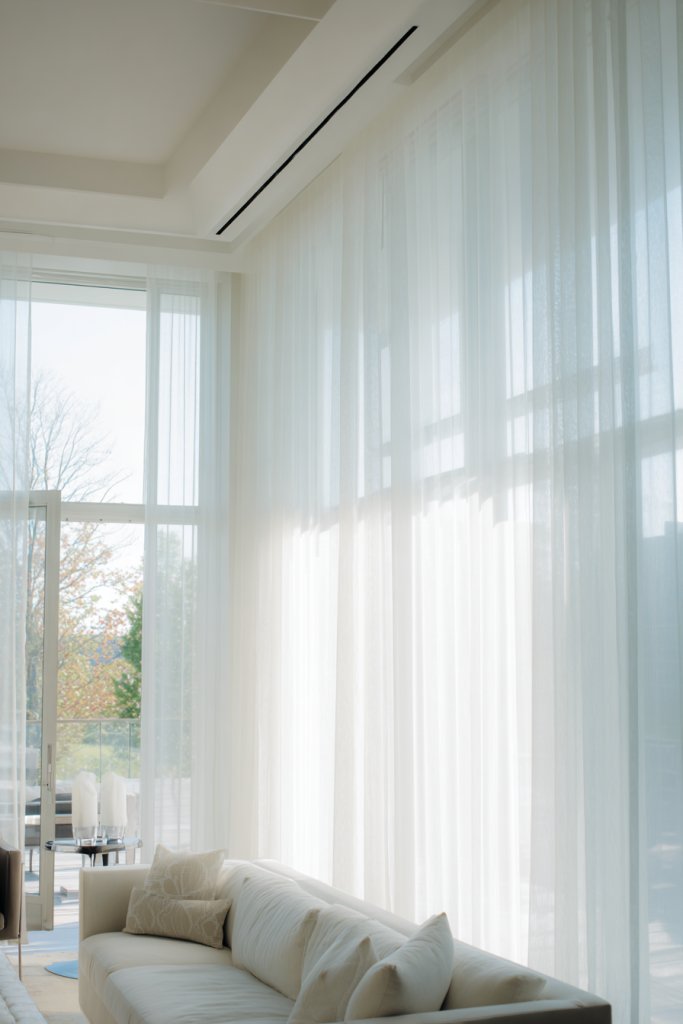
Heavy curtains or dark blinds can make your apartment feel gloomy and closed in. Light, sheer window treatments brighten up the space and invite natural light to flow freely. They create an airy, open feel that instantly lifts your mood. If you crave sunshine and a more spacious vibe, this tip is essential.
Imagine delicate, sheer curtains in a soft ivory fluttering gently in the breeze, diffusing sunlight softly across your room. The light fabric filters out harsh glare while maintaining privacy. When paired with minimalist window frames, the overall look is clean and modern. The airy fabric adds a touch of softness, making your space feel larger and more inviting.
Choose lightweight fabrics like linen, voile, or chiffon for a breezy feel. For evening privacy, layer with blackout roller blinds or shades that can be rolled up during the day. Use neutral or pastel shades to keep things bright and fresh or add a hint of color for personality. Consider floor-to-ceiling curtains for a dramatic, elongating effect in larger windows.
Measure your windows accurately before purchasing. Install a simple curtain rod or track at ceiling height for a more spacious appearance. Opt for lightweight, easy-to-maintain fabrics that can be washed easily. Hang the curtains just above the window frame to maximize natural light. Keep hardware minimal and sleek, blending seamlessly into your decor. Regularly wash and iron to keep the fabric looking pristine.
Add decorative curtain ties or subtle trims that match your interior scheme. Change sheer fabrics seasonally—light and airy for summer, warmer textures for winter. Use layered treatments for a sophisticated look, combining sheers with blinds. Personalize with small decorative rods or finials that reflect your style—brass, matte black, or wood.
Bright, light window treatments transform your space into a cheerful, welcoming environment. They show that simple updates can make a big difference in ambiance. When your room floods with natural light, your mood and confidence in your decor choices naturally rise. It’s a small change with a huge impact, making your apartment feel more like home.
13. Incorporating Natural Materials for Warmth
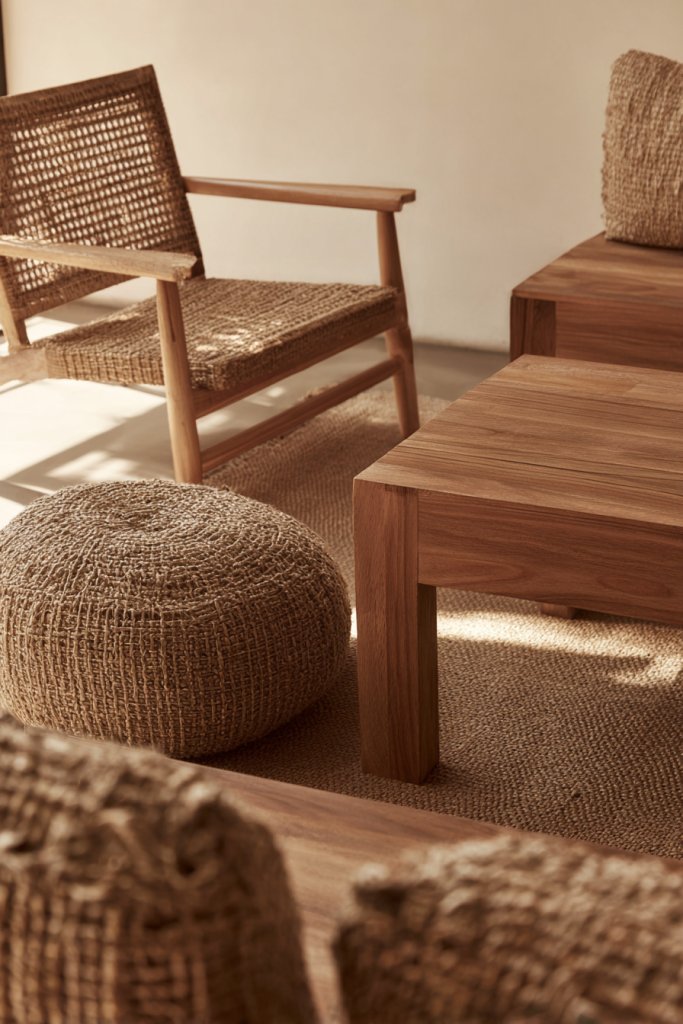
Does your modern apartment feel cold or impersonal? Incorporating natural materials like wood, rattan, or jute instantly adds warmth and texture. These elements evoke a cozy, organic vibe that makes your space feel more inviting. If you crave a space that feels grounded and authentic, this is your answer.
Picture a wooden coffee table with a rough, live-edge finish paired with woven rattan chairs. A jute rug underfoot adds a tactile layer that invites barefoot comfort. Natural fiber baskets hold miscellaneous items, while raw wood accents on shelves or frames bring a rustic charm. The combination of textures and earthy tones creates a warm, layered look that’s both stylish and soothing.
Mix different natural materials for variety—think bamboo blinds, cork accessories, or linen upholstery. For a coastal or boho vibe, incorporate rattan or wicker furniture. Seasonal swaps, like adding wool throws or cotton cushions, can refresh the look. Keep the color palette earthy—beige, taupe, soft browns—to maintain harmony. Use natural materials as accents rather than dominant features for subtle warmth.
Select furniture and accessories made from authentic natural fibers or woods. Avoid overly processed or synthetic substitutes, which can detract from the organic feel. Combine textures by layering woven, rough, and smooth surfaces. Use natural finishes like oil or beeswax on wood to enhance grain and warmth. Pair with neutral wall colors to highlight the textures. Regularly dust and treat wood to keep it looking its best.
Incorporate handmade or vintage pieces for authenticity. Use textiles like linen or cotton in muted tones for cushions and curtains. Personalize with small handcrafted decor, such as woven wall hangings or ceramic bowls. Mix modern pieces with rustic accents to create a balanced, eclectic look. Keep the space feeling fresh by swapping textiles seasonally.
Using natural materials connects your home to nature, boosting your sense of tranquility. It shows that organic textures can elevate your decor effortlessly. When your space feels warm and authentic, your comfort and confidence grow. Embrace these materials to craft a space that’s both stylish and soulful—your personal sanctuary.
14. Statement Lighting Fixtures as Focal Points
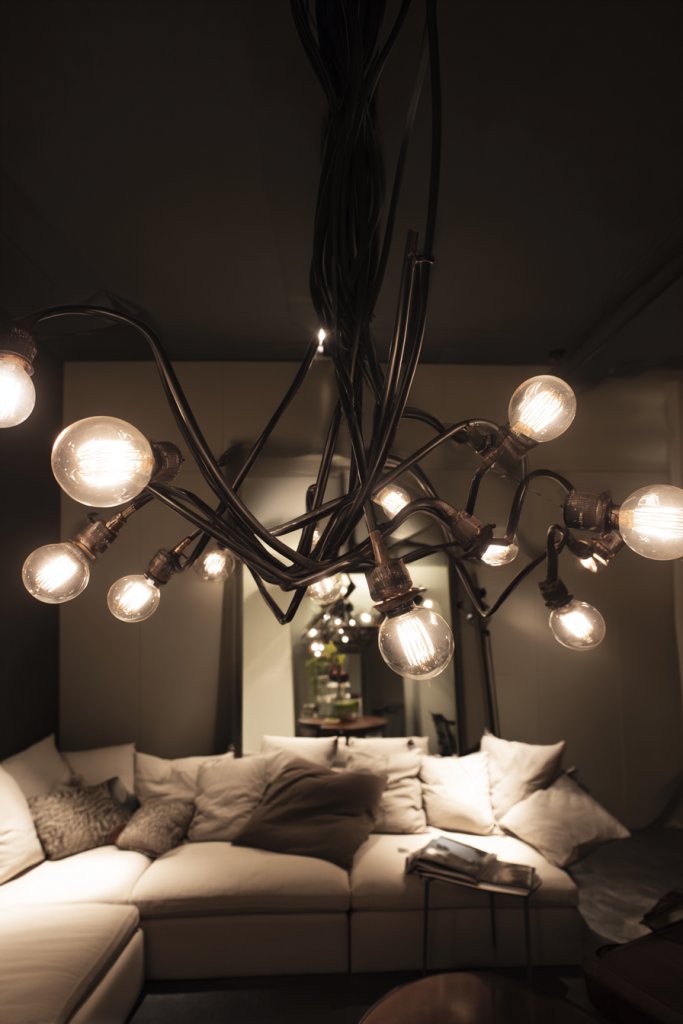
Is your living room missing that wow factor? A statement lighting fixture can instantly serve as the room’s focal point and elevate your decor. It draws attention and adds personality, transforming a bland space into something memorable. If you want to make a bold design statement without clutter, this is your move.
Imagine a large, sculptural pendant with an interesting shape hanging above your seating area. Its metallic finish or intricate design catches the eye, becoming a piece of art itself. The glow it emits creates a warm, inviting atmosphere that sets the tone for the entire room. When turned on, it commands attention and anchors your decor style—be it modern, industrial, or eclectic.
Choose fixtures that match your aesthetic—think oversized globes, geometric shapes, or vintage-inspired chandeliers. For smaller spaces, a single striking pendant or a cluster of mini pendants works well. In more casual settings, opt for simple industrial or rustic fixtures. Use dimmable bulbs to control mood and ambiance, especially for evening gatherings. Keep the scale proportional to your room size to avoid overpowering the space.
Select a statement fixture that complements your ceiling height and decor style. Install at a height that balances the room—about eye level or slightly above. Use appropriate electrical hardware and consider professional installation for complex fixtures. Pair with soft, warm bulbs to enhance the fixture’s design and create a cozy glow. Keep the area around the fixture clear of obstructions for maximum visual impact.
Mix and match fixture styles with your existing decor—metal, glass, or wood finishes—to reflect your personality. Add dimmable controls for flexibility, and use warm-colored bulbs for a cozy effect. Incorporate decorative elements like fabric shades or unique bulbs to personalize further. Your fixture should stand out but also harmonize with the overall aesthetic.
A statement light fixture demonstrates your boldness and sense of style. It turns a functional element into a focal point that sparks conversations. When you choose the right piece, your entire room feels more curated and intentional. It’s an easy upgrade that makes a big difference—trust your eye and go for it!
15. Smart Use of Mirrors to Enhance Space and Light
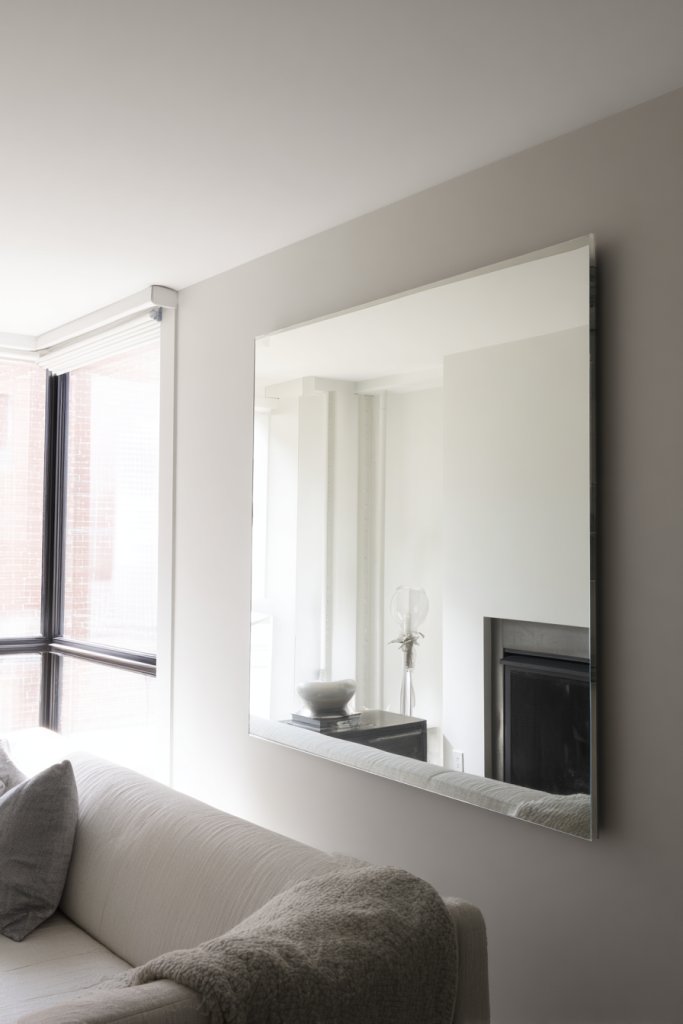
Feeling cramped or dim in your apartment? Mirrors are the secret weapon to make your space feel larger and brighter. They reflect natural and artificial light, creating an illusion of depth and openness. If you want to instantly boost your room’s vibe, mirrors are your best friend.
Imagine a large, frameless mirror leaning against a wall, reflecting a cozy reading nook or a window with sunlight streaming in. Multiple smaller mirrors arranged artistically can add visual interest and bounce light around the room. The reflective surfaces amplify the sense of space, making even small rooms feel expansive. When strategically placed, mirrors can also serve as decorative elements that enhance your interior style.
Use full-length mirrors in bedrooms or entryways to serve functional and aesthetic purposes. Hang decorative mirrors above sofas or fireplaces to act as focal points. Play with shapes—round, oval, or geometric—for variety. For restricted spaces, lean mirrors instead of mounting for a casual, stylish look. Combine with lighting to maximize brightness and spatial effect.
Position mirrors across from windows or light sources to reflect as much light as possible. Secure wall-mounted mirrors with appropriate hardware—consider safety when placing in high-traffic areas. Use frames that match your decor—metal, wood, or minimalist styles. Keep the mirror surface clean and streak-free for maximum impact. Experiment with placement until the room feels open and inviting.
Decorate with framed mirrors that complement your style—vintage, modern, or eclectic. Use multiple small mirrors to create a gallery wall, adding visual interest and depth. Incorporate decorative frames or mats to enhance the look. Keep the reflective surfaces free of dust and smudges to maintain clarity.
Mirrors are a simple, affordable way to transform your space. They boost confidence by making your apartment feel bigger and more luminous. When well-placed, they subtly elevate your decor style. Trust in the power of reflection—your space will feel more open and welcoming with this trick.
16. Creative Use of Partition Screens for Privacy
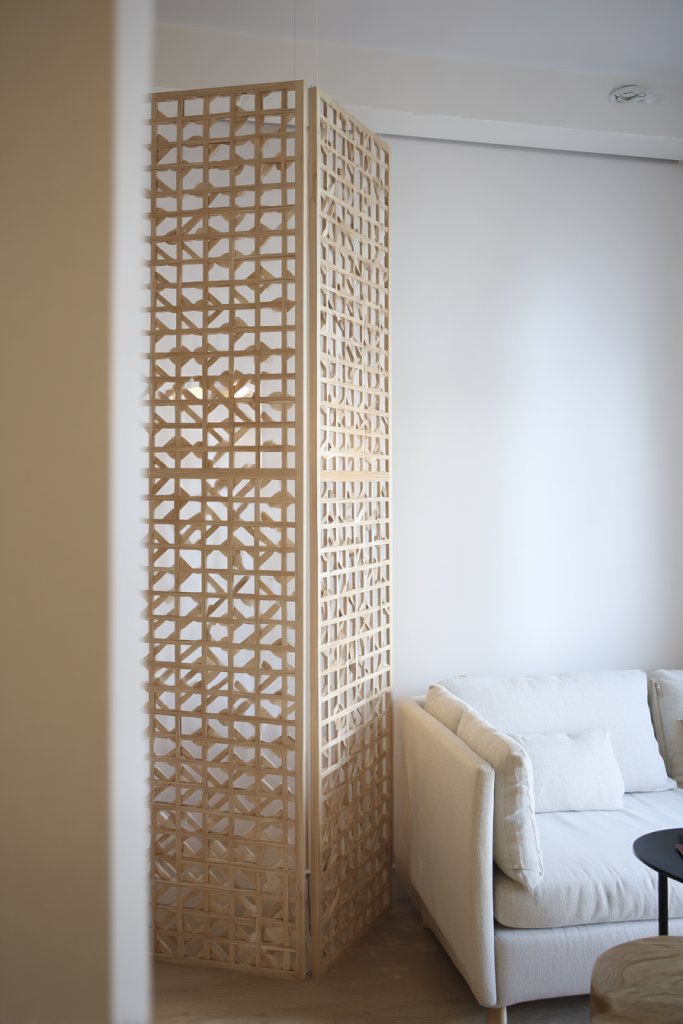
Need to create separate zones without sacrificing openness? Partition screens offer a stylish, flexible way to add privacy and define areas. They’re perfect for small apartments where walls are limited but division is still necessary. If your space needs some visual separation, screens are your secret weapon.
Imagine a lightweight, foldable screen with a geometric or textured pattern standing between your sleeping area and living space. When unfolded, it creates a cozy, semi-private nook. The screen’s design complements your decor—metal accents, fabric panels, or painted wood. The result is a chic, functional feature that adds personality and separation without closing off the space.
Choose from various materials—woven rattan, printed fabric, or sleek metal—to match your style. Use screens as backdrops for your bed or seating area, or as room dividers during entertaining. For a more permanent look, consider sliding or bi-fold versions integrated into your decor. Change the panels seasonally or for special occasions to keep things fresh.
Select a lightweight, portable screen that fits your space and style. Position it where you need privacy or separation—near beds, desks, or entry points. Use hinges or freestanding bases for stability. Incorporate decorative elements—like painted panels or textured fabrics—to personalize the look. When not in use, fold or move the screen aside easily. Regularly check stability and clean the surfaces for longevity.
Add personal touches like fabric covers, painted designs, or decorative trims. Use the screen to showcase your favorite textiles or artwork—if restrictions allow. Experiment with transparency—semi-opaque panels can offer privacy while maintaining openness. Incorporate lighting behind or around the screen to highlight its design.
Partition screens are a creative, flexible way to organize your apartment and add style. They show that you can carve out private spaces in a small footprint without walls. When you master this, your home becomes more functional and personalized. It’s a simple idea that elevates your entire living experience.
17. Compact Indoor Plants for a Touch of Nature

Thinking of adding greenery but worried about space or maintenance? Compact indoor plants are perfect for bringing fresh vibes into your apartment without clutter. They improve air quality, boost mood, and add a natural aesthetic. If you want a bit of nature without the fuss, this tip is for you.
Picture a small succulent arrangement on a side table or a tiny fern in a hanging basket. These plants thrive in limited space and require minimal care. Their lush green leaves add a pop of color and texture, softening the room’s overall look. When grouped with decorative pots or containers, they create a charming mini-garden vibe that feels lively and organic.
Choose low-maintenance options like succulents, cacti, or air plants. Place them on shelves, window sills, or small tables—anywhere they can catch some indirect light. Use decorative containers—ceramic, metallic, or woven—that match your decor style. Rotate or swap plants seasonally for variety. Incorporate small terrariums or wall-mounted planters for even more space-saving options.
Select plants suitable for your light conditions—bright windows for succulents, shadier spots for ferns. Use appropriate pots with drainage and decorative covers to match your aesthetic. Water sparingly and avoid overwatering—most require only weekly or bi-weekly watering. Place plants where they won’t be knocked over or obstruct pathways. Regularly dust leaves and check for pests.
Create themed plant displays—succulents in geometric containers or herbs in vintage pots. Personalize by adding decorative stones or labels. Incorporate small LED grow lights or fairy lights around the plants for extra charm. Use plants to frame windows or corners, making the space feel lush and inviting.
Indoor plants are a simple way to connect with nature and boost your mood. They show that you don’t need a big yard to enjoy greenery—small spaces can be lively and fresh. When your plants thrive, your confidence in decorating and caring for your home grows. Embrace these little touches of nature for a happier, healthier living space.
18. Textured Accent Walls for Visual Interest

Bored with plain walls? A textured accent wall adds depth and visual intrigue without overwhelming your space. It creates a focal point that elevates your entire decor. If you want to add personality with minimal effort, this idea is a game-changer.
Imagine a wall covered in a subtle, textured wallpaper with a pattern that mimics natural materials like stone or linen. Alternatively, a painted wall with a raised plaster finish or 3D wall panels creates tactile interest. The contrast between smooth and textured surfaces draws the eye and adds dimension. In a neutral room, this wall becomes the standout feature, adding sophistication and depth.
Choose textures that complement your decor—woodgrain wallpaper, linen-look finishes, or geometric plaster patterns. Keep the rest of the walls simple to let the accent wall shine. Change textures seasonally by adding removable wallpaper or wall decals if restrictions apply. Use accent walls behind your sofa, bed, or fireplace to anchor the room visually.
Select a textured wallpaper or wall treatment suited for your space—consider humidity and durability. Prepare the wall surface by cleaning and smoothing it out. Install wallpaper carefully, following manufacturer instructions, or apply plaster finishes with proper tools. Use painter’s tape to create clean lines if doing geometric patterns. Seal or protect textured finishes as needed to maintain longevity.
Coordinate your accent wall with other decor elements—think matching textiles or accessories in similar tones. Add lighting—like wall sconces or picture lights—to highlight the texture. Change or update the texture seasonally or with different themes for variety. Keep the surrounding decor minimal to focus attention on the textured surface.
A textured accent wall demonstrates bold, creative decorating. It proves that small details can transform your space into something extraordinary. When you see how a simple wall treatment elevates your decor, your confidence to experiment with other design ideas grows. It’s a stylish, impactful upgrade that’s worth trying.
19. Functional Wall-Mounted Desks for Small Spaces
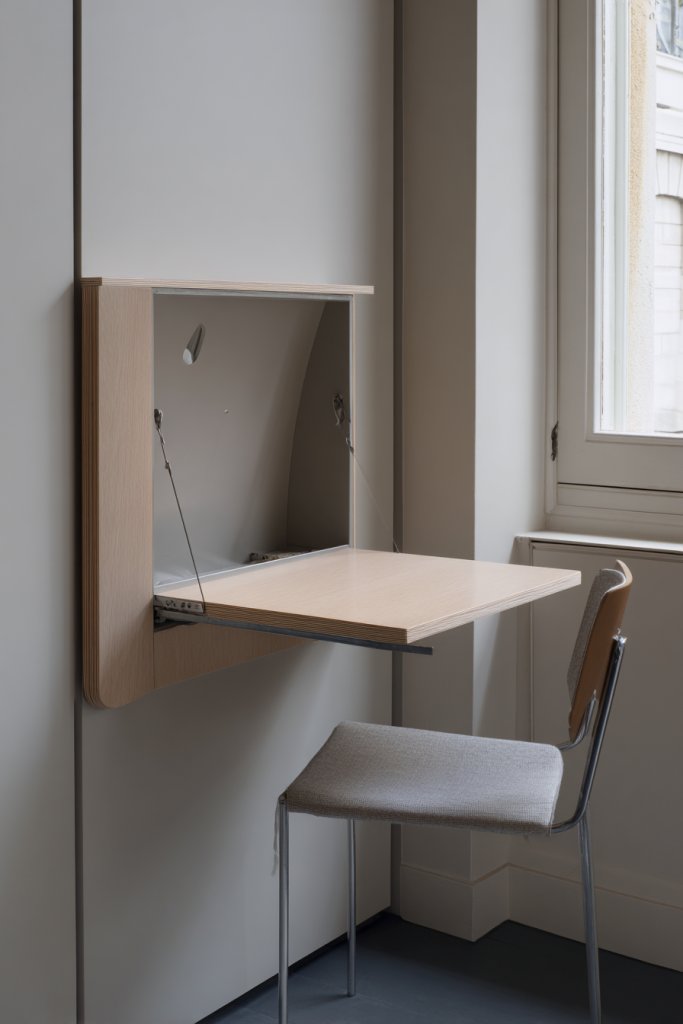
Struggling to find a dedicated workspace in your tiny apartment? Wall-mounted desks offer a practical solution that frees up precious floor space. They turn a corner or a wall into a sleek, functional station for work or study. If your space is limited, this idea helps you stay productive without clutter.
Imagine a slim, fold-down desk mounted neatly on a wall, with a simple chair tucked underneath. When folded up, it disappears, revealing a clean wall surface. When opened, it provides a sturdy surface for your laptop and essentials. Pair with minimalist shelving or storage cubes nearby for organization. The overall look is modern and uncluttered, perfect for apartment living.
Choose from different styles—sleek wood, painted MDF, or metal surfaces—depending on your decor. Use fold-out or slide-out designs for maximum flexibility. In bedrooms or living rooms, position near windows or lighting for comfort. Add small organizational accessories—like hooks or clips—for pens, chargers, or notebooks. Adapt the desk height and size to suit your needs.
Measure your available wall space and select a suitable wall-mounted desk that can fold away when not in use. Install sturdy anchors and hardware—preferably professional if you’re unsure—to ensure safety. Use a level to align the desk perfectly. When deploying, clear the wall area, and double-check stability. Keep the surface clean and free of clutter for maximum efficiency. Regularly inspect mounting hardware for safety.
Add a small, decorative cushion or a stylish chair to elevate the look. Personalize with a small bulletin board or magnetic strips nearby for notes and accessories. Use colorful or patterned desk mats to infuse personality. Keep the design simple and functional—avoid overloading with accessories. This setup encourages productivity while maintaining a sleek aesthetic.
Wall-mounted desks prove that small spaces can be highly functional and stylish. They show that clever design can turn tight quarters into efficient work zones. When your workspace is organized and accessible, your confidence in your home’s functionality grows. Embrace this smart, space-saving idea—you’ll wonder why you didn’t do it sooner.
20. Layered Lighting with Candles and Fairy Lights

Overly harsh lighting can kill the cozy vibe in your apartment. Layered lighting with candles and fairy lights creates a warm, inviting glow perfect for relaxing or entertaining. It’s an inexpensive way to add ambiance and personality. If your space feels dull or clinical, this approach instantly makes it more welcoming.
Picture a corner with a cluster of candle holders in varying heights, casting flickering shadows. Nearby, fairy lights are draped along shelves or wrapped around furniture, emitting a gentle, twinkling light. The combination softens the room, creating a layered glow that changes with your mood. When dimmed, the space feels intimate and magical, perfect for unwinding or hosting friends.
Use flameless LED candles for safety or scented candles for added aroma. String fairy lights in warm white or soft color tones—avoid overly bright or cold LEDs. Hang fairy lights behind furniture, along mantels, or across ceilings for a whimsical effect. Combine with table lamps or sconces for a balanced, layered look. Adjust the intensity to match the occasion—bright for reading, dim for ambiance.
Arrange candles on trays or decorative holders on tables or shelves. Use battery-operated candles for safety and convenience. Hang or drape fairy lights strategically—around beds, mirrors, or along wall edges. Use timers or remote controls to easily switch between different lighting layers. Keep the space tidy, ensuring cords are hidden or secured to prevent tripping hazards. Regularly replace batteries and clean light fixtures.
Personalize with themed candles or fairy light colors matching your decor. Incorporate decorative lanterns or vintage holders for a rustic look. Use candles in different scents to evoke mood and atmosphere. Change the arrangement seasonally or for special occasions to keep things fresh. Add decorative elements like ribbons or charms for extra charm.
Layered lighting transforms your apartment into a cozy retreat, proving that atmosphere matters just as much as decor. It encourages you to host more gatherings or enjoy quiet evenings. When your space glows invitingly, your confidence in your home’s ambiance increases. It’s a simple, magical upgrade that makes a big difference—trust the power of light.
21. Modular Seating for Flexible Arrangements

In a small apartment, flexibility is key. Modular seating allows you to adapt your furniture layout to different needs—whether it’s movie night, a gathering, or quiet relaxation. It’s a versatile, space-efficient solution that keeps your decor fresh and functional. If you want to maximize your seating options without clutter, this is the way to go.
Imagine a set of modular sofas with pieces that can be pushed together or separated. When arranged as a sectional, it creates a cozy, communal vibe. When separated, it offers multiple seating zones. The sleek, modern design with neutral upholstery fits various decor styles, from minimalist to eclectic. The flexibility allows you to reconfigure your space quickly and easily, making your apartment adaptable and stylish.
Choose pieces with different configurations—corner units, armless chairs, ottomans—that can be combined in multiple ways. Use contrasting colors or textures for visual interest, or keep everything uniform for a sleek look. Incorporate storage ottomans or lightweight pieces for easy movement. Seasonal or mood-based variations might include adding throws or decorative pillows in different hues.
Start by assessing your space and deciding on the configurations that work best. Opt for lightweight, modular pieces that are easy to move around—especially important in small spaces. Connect units with clips or simply arrange them closely to create a seamless look. Use rugs to anchor different zones, and position furniture to promote easy flow and conversation. Regularly clean and reconfigure to keep the space dynamic.
Decorate with cushions and throws that match your current decor. Incorporate small tables or trays nearby for convenience. Personalize with themed accessories or seasonal accents to keep the look fresh. Mix and match textures—leather, fabric, or velvet—to add depth and interest. Keep the arrangement playful and adaptable to suit your mood or needs.
Modular seating shows that you can be both stylish and adaptable in small spaces. It encourages creativity and experimentation with your layout. When your furniture can change as easily as your mood, you feel more in control and confident as a decorator. Embrace this flexibility—your home becomes an ever-evolving, inviting space.
22. Customized Storage Solutions with Baskets and Boxes
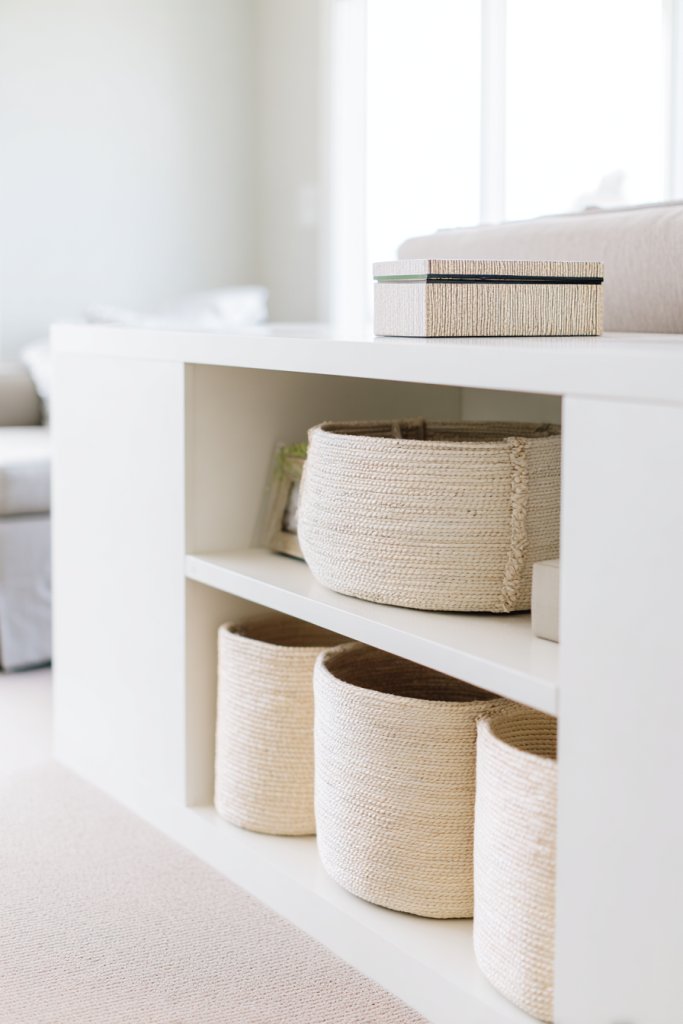
Messy, cluttered spaces sap your energy and make your apartment feel chaotic. Customized storage solutions like baskets and boxes keep things organized and add a decorative touch. They hide everyday clutter while showcasing your style. If you want a tidy, personalized home, this is your secret weapon.
Visualize woven baskets in natural tones tucked under a console table, or colorful fabric bins stacked neatly in a corner. These containers hold magazines, throws, or accessories, turning clutter into a curated collection. Decorative boxes on shelves or inside cabinets add a layer of visual interest while providing storage. Their varied shapes and textures contribute to a layered, styled look that feels intentional.
Choose baskets and boxes in materials that match your decor—woven, metal, plastic, or fabric. Use labels or tags to categorize contents for quick access. Incorporate seasonal colors or patterns to keep things fresh. Small, stackable boxes are perfect for organizing essentials, while larger baskets work for bulkier items. Mix open and closed storage for balance.
Identify clutter hotspots—under the sofa, inside closets, or on shelves—and select suitable containers. Measure spaces to ensure a good fit. Use uniform styles for a cohesive look or mix textures for visual interest. Place frequently accessed items in easy-to-reach baskets or boxes. Regularly declutter and reorganize to maintain neatness. Consider DIY options for a personal touch.
Decorate baskets with ribbons, fabric liners, or painted designs. Personalize boxes with labels or monograms. Incorporate thematic containers—like beach-themed baskets or vintage trunks—for character. Use decorative fillers inside for a polished look. Keep the organization system flexible to adapt to changing needs.
Customized storage solutions show your attention to detail and style. They make your apartment feel more orderly and inviting. When everything has a place, your confidence in your home’s design increases. It’s a simple, effective way to elevate your decor and keep clutter at bay—your space, your rules.
23. Monochrome or Soft Color Accents for a Calm Vibe
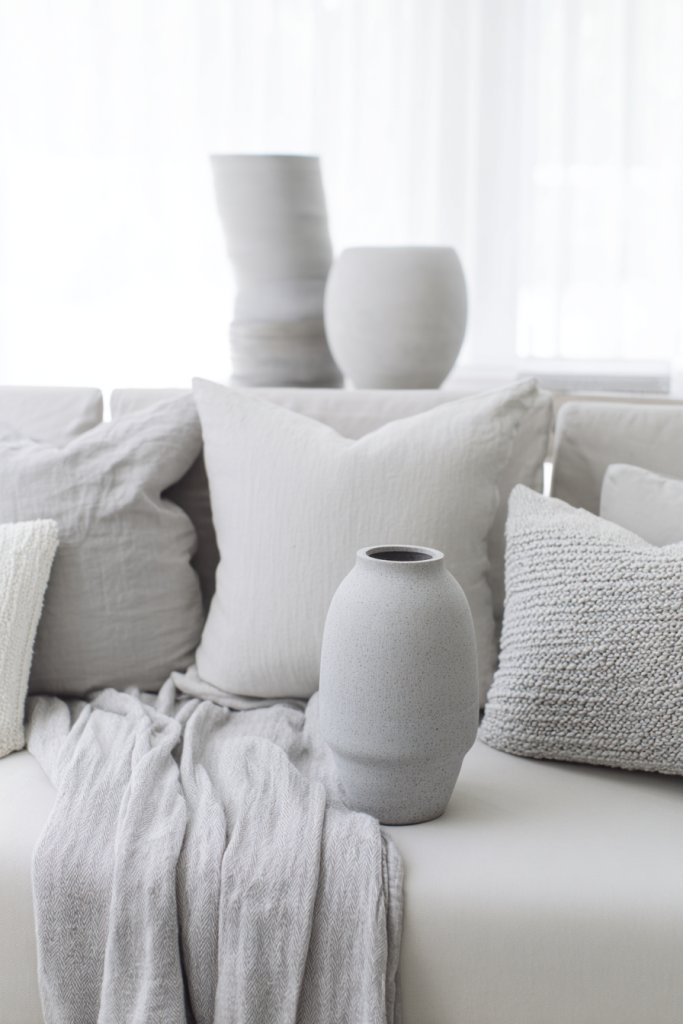
Want your apartment to feel calm and cohesive? Monochrome or soft color accents are perfect for creating a serene atmosphere. They unify your decor, making the space look polished and balanced. If cluttered or overly busy spaces overwhelm you, this approach brings harmony and tranquility.
Picture a living room with a palette of soft greys, blush pinks, and warm taupes. Cushions, throws, and accessories in matching tones create a harmonious look. Subtle variations in texture—velvet, knit, or woven—add depth without disrupting the calm. The overall effect is soothing and sophisticated, inviting relaxation and mindfulness.
Use a base of neutral shades and add pops of soft pastel or muted hues for interest. Mix textures and finishes—matte, satin, or matte metals—to keep things lively yet subtle. Incorporate small accents like decorative pillows, vases, or art in similar tones for a cohesive look. Seasonal updates can include changing accent colors or adding metallic touches.
Choose a neutral or pastel color scheme for walls, furniture, and textiles. Use matching or complementary shades for cushions, throws, and accessories. Keep decor minimal and coordinated—avoid busy patterns or contrasting colors that break the harmony. Incorporate metallic or textured elements subtly to add interest. Regularly update accessories to reflect your evolving style.
Add personal touches with favorite fabrics or textures—think velvet cushions or soft wool throws. Use metallic or matte accents to elevate the look. Incorporate personal mementos or small artworks in similar tones for a curated feel. Keep the overall aesthetic calm and cohesive for a relaxing environment.
A monochrome or soft color scheme proves that simplicity can be stunning. It creates a peaceful retreat that’s easy to update and maintain. When your space feels calm and unified, your confidence in your decorating skills naturally grows. Embrace this minimal yet stylish approach for a home that soothes and inspires.
Conclusion
With these varied apartment living room design ideas, you’re equipped to create a space that balances comfort and style effortlessly. Don’t hesitate to experiment with different layouts, colors, and decor to reflect your personality. Embrace the opportunity to make your living room a beautiful, functional retreat—your perfect space is just a few inspired choices away!
Leave a Reply